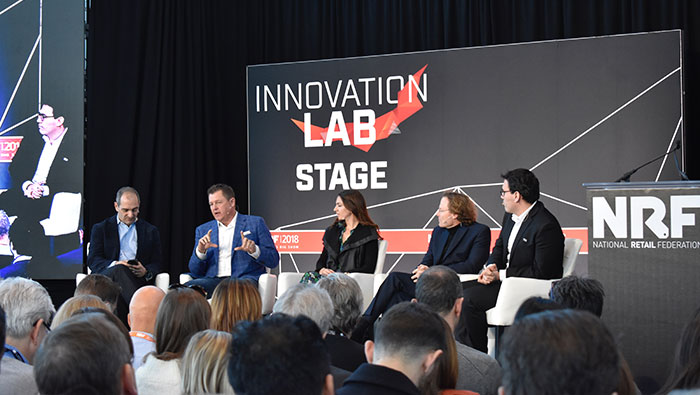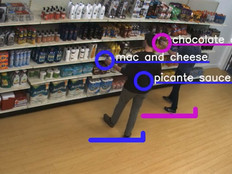NRF: How Retailers Can Use AI to Solve Problems and Increase Sales
Artificial intelligence isn’t coming to terminate traditional retailers — just like in “Terminator 2: Judgment Day,” it’s actually here to help.
That was a key takeaway from a panel on robotics and AI held at NRF 2018: Retail’s Big Show in New York City on Jan. 14. Instead of seeing AI as a threat that eliminates jobs through automation, retailers should embrace the technology as a tool that can solve their business problems, retail AI experts said.
Michelle Bacharach, co-founder and CEO of FindMine, a company that uses supervised machine learning techniques to create complete outfits around each product an apparel retailer sells, said on the panel that AI should not be an end in itself.
“If you start there, you’ve already failed,” she advised retailers. “It’s a means to an end to solve a problem.”
SIGN UP: Get more news from the BizTech newsletter in your inbox every two weeks!
Use AI to Help Retail Store Staff
Joe Jensen, vice president and general manager of the retail solutions division at Intel, told attendees that if retailers have access to more data, they will benefit. AI provides retailers with more data about inventory and how customers behave in stores, and it is becoming less expensive and easier to use AI to turn data into “simple, actionable insights for your staff.”
IDC analysts predict in the research firm’s “IDC FutureScape: Worldwide Retail 2018 Predictions” report that by 2019, 40 percent of retailers will have developed a customer experience architecture supported by an AI layer.
Embedded AI “enables an innovative approach, changing the knowledge map from customer behavior to the characterization of its social context, potential needs and decision making,” the report states. According to the IDC report’s authors, 37 percent of retailers are already adopting or plan to adopt AI for customer experience personalization in the next 12 months. And, the IDC report’s authors expect “AI-enabled user experience will manifest in broader adoption of voice and gesture interaction, slowly at first but quickly gathering pace.”
Jensen said that in physical stores, retailers can see how their customers interact with their products directly, but are not collecting enough data on that activity to turn it into actionable intelligence.

From left: Pano Anthos, Joe Jensen, Michelle Bacharach, Bernd Shoner and Marco Mascorro discuss AI and robotics at NRF 2018.
For example, Jensen said, retailers could use computer vison technology to determine whether customers reach for products on the top, middle or bottom shelf, and see how they handle products as they move around stores. They could then automate the collection of that data, process it and use AI to analyze behavior patterns. That, in turn, could lead retailers to optimize where they place products to drive more sales. That kind of observation can be done by human sales representatives, but AI can automate it, allowing sales associates to interact with customers more and perform other tasks.
“We really do believe the physical store is how consumers prefer to shop,” Jensen said. The challenge is that, as retailers have laid off sales associates to cut costs, the experience has become more negative for customers. The old profit-and-loss equation needs to be rebalanced to bring more technology into stores, so that retailers can better position their products and augment the capabilities of their staff, Jensen said.
Bacharach said that FindMine’s technology looks at a retailer’s entire catalog, including product descriptions, and uses natural language processing to categorize the merchandise so that it can create outfits that go well with a specific product. By giving customers more complete outfits up front when they pick a product, the company helps retailers put appealing apparel pieces in front of customers more quickly, which helps increase sales.
Why Haven’t More Retailers Adopted AI?
Retailers face “tremendous pressure” to meet quarterly sales and profit targets, Jensen said, which has driven down investment in new technologies like AI.
However, he said, there is a new class of “digital native” retailers that either started online and are now branching into physical stores or that are run by executives who started their careers in online retail. These executives, Jensen said, “come in with a list of the data they know they need to run their businesses effectively,” and they design stores around getting that data.
In the future, Jensen said, “to get the efficiencies they need to survive and thrive” retailers are going to “have to allocate more resources to tech.” Echoing that, Bacharach encouraged retailers who might have had a poor experience with an AI vendor a few years ago not to dismiss the technology entirely. “By throwing the baby out with the bathwater, you could be missing this massive opportunity,” she said.
Bernd Schoner, co-founder and CEO of DeepMagic, a tech startup that uses AI, cameras and computer vision to monitor shopping activities, flag suspicious behavior and provide real-time information to store managers and associates, says the goal of his company’s technology is to automate retail transactions and make them “frictionless.”
Schoner said his company does not yet have any live customers using its platform, but he is optimistic that retailers will adopt AI because they face more pressure to innovate than ever before.
“AI is more revolutionary than RFID,” he said, referring to radio frequency identification, a key technology in modern inventory management. AI gives retailers much more data about their inventory than RFID, he said.
“What has changed is retailers have a gun to their head. That will hopefully help us make that change happen and get them to act on these opportunities that they have.”
For our full array of articles and videos from the conference, check out BizTech’s coverage of NRF 2018 conference here.









